Are you looking for a business opportunity that can help you earn money by lending? Then, having a money lending app like LendingClub is a considerable idea for you.
Launched in 2007, the platform has transformed the lending experience. It has not only eased the financial strain on users but also offered a straightforward way to borrow and manage finances.
Relying on such a financial experience offering, Lending Club has grown to a user base of 5 million+. Further, offering them innovative financial products and services.
Such numbers reflect a potential opportunity for the new-gen entrepreneurs to enter the peer-to-peer lending segment & build a profitable business.
But with such a common concern that arises is: “How to create an app like LendingClub?”
If you are also having such a concern, then this blog is for you.
In this blog, we will go deep down to every aspect that can help you better conceptualize the opportunity and your next venture.
Key Takeaways:
The expected growth of the global money lending market makes lending apps like LendingClub a considerable option for modern-day entrepreneurs.
To create a money lending app, conduct detailed market research, understand the latest trends, competitive feature offerings, and plan accordingly.
The cost to create a money lending app can range anywhere between $15,000 and $130,000, or even more in certain cases.
Pay attention to the challenges while developing an app like LendingClub, which include data security, regulatory compliance, and users' trust-based factors.
AI, voice chat, and other industry trends can be leveraged to add a competitive edge to your money lending app.
What is Lending Club?
LendingClub is a US-based fintech brand established to transform the traditional banking system.
It defines itself as “only full-spectrum fintech marketplace bank and first public US Neobrand”. From offering consumer and commercial loan products to investment and deposit solutions, LendingClub offers it all.
To simplify, it can be mentioned that Lending Club is a one-stop institution satisfying both the borrowing and investing needs of Americans.
Lending Club has gained momentum by offering differentiated products and services, which include:
-
Offering unsecured personal loans for an amount up to $1K- $50K for about 24–84 months, at an interest rate ranging from 7.90% to 35.99%.
-
Transferring the funds within 24 hours of approval.
-
Eliminating the application and prepayment fees makes LendingClub a profitable choice for borrowers. However, it charges an orientation fee of 1-8% of the total loan amount.
-
Along with personal loans, it also offers patients financing and auto refinancing.
So, if you are planning to create a loan lending app like LendingClub, then you should know the differentiating factor that you need to have.
Along with such a differentiation factor, you need to be aware of how LendingClub works so that you can strategize your platform accordingly.
How LendingClub Works?
LendingClub started as a peer to peer lending app, which means it acts as a platform that connects borrowers and investors. Hence, making the process much easier.
However, after 2020, LendingClub has shifted its approach, has ceased P2P lending, and is focusing on institutional/bank-funded loan options.
If you are planning to create an app like LendingClub, then you should know the basic functioning of the app. So, let’s explore the functioning of the LendingClub mobile app.
-
Users create an account, verifying their identity and linking their bank accounts
-
Once the profile has been verified, borrowers fill out the loan application. The application requires details like loan amount, purpose, and employment details.
-
LendingClub app then performs a soft credit check to recommend personalized loan offers.
-
Once the user accepts the loan offer, the hard credit check is conducted. Such is done based on documents like income proof, and accordingly, the approval is provided.
-
After approval, the amount is transferred to the user’s linked bank account.
-
Further, using the app dashboard, users can track their repayment schedule, dues, and credit improvement tips.
-
After its transformation, as an institutional/bank-based lending app, it also has banking features. Such includes account management, wallets, and other payment options.
The business model of LendingClub can further be summarised as:
Evaluating Credit Score > Checking Loan Offers > Filling Application > Loan Approval > Disbursement > Repayment
To be eligible for a loan from LendingClub, the users need to fulfill:
-
Credit score requirements of at least 600. (LendingClub’s prime borrowers have an average FICO credit score of 705).
-
Applicant needs to have a debt-to-income ratio of less than 40%. Apart from this, there are no specific income requirements.
-
Applicant needs to have a co-borrower in case of larger loan amounts.
Apart from the business model, it is also important to understand how its mobile application works so that you can plan for a LendingClub like App Development.
-
App Installation and User Registration
-
Filling Up the Loan Application Form
-
Selecting a perfect loan offer available based on credibility.
-
Submitting Request & Waiting for Approval
-
Real-time tracking of the application, approval, and repayment status.
Lending Club Market Stats
LendingClub is delivering strong growth despite the global economic uncertainties. Its positive growth can further be justified through the following statistics:
-
LendingClub’s current market capitalization stands at 1.45 billion.
-
5 million+ users & a total revenue of $217.7 million (20% higher than previous F.Y.)
-
Lifetime originations have crossed $100 billion in 2025 Q1.
-
$10.5 billion in assets and $8.9 billion in deposits
-
2025 Q2 PPNR estimated to grow at 27-46% Y-o-Y.
Let’s take a look at some key statistics from the money-lending sector:
-
The Global Consumer Lending market is expected to grow to $1931.2 billion by 2033 from $1173.6 billion in 2024.
-
The global auto loan market is expected to grow at 8.3% CAGR, hence it will contribute to a potential rise in the auto financing and loan service requirements.
-
The US BNPL segment is expected to grow at a 25.3% CAGR and 9% CAGR globally by 2028.
The above-mentioned statistics are the true reflection of the market opportunity that lending apps like LendingClub can leverage. Hence, you can plan to make an app like LendingClub and target such a growing industry.
Benefits of Investing in LendingClub like app development
Investing in a LendingClub like app can offer several benefits to the new-age entrepreneurs like you. These benefits can be identified as:
1. High Market Demand and Growth Potential
As mentioned, the global consumer lending sector is expected to reach $1931.2 billion by 2033. Also, the digital transformation and the customer demand for faster and simpler financing solutions are making LendingClub like App Development a perfect choice for new-age entrepreneurs.
2. Fulfill The Unmet Demand Left by LendingClub
As LendingClub has shifted its focus from being a P2P lending app to an institutional and bank-based lending platform, it has left a market gap to fill. Hence, investing money to develop a loan lending app like LendingClub with P2P facilities can help entrepreneurs get a market edge.
3. Brand Differentiation With Modern Features
Rather than focusing on LendingClub like app development, the entrepreneurs can plan to build an app like LendingClub but with modern features. They can plan to integrate AI in loan lending apps or other interesting features like financial health monitoring and more.
4. Diversified Platform Options
Lending Mobile App Ideas can offer diversified solutions to entrepreneurs. From peer-to-peer lending to institutions/bank-based lending, or any other lending or investment format. You can hire dedicated developers, discuss your requirements with them, and plan accordingly.
5. Creating Social and Economic Impact
Planning for LendingClub clone app development can help you create both the social and economic impact.
-
Social impacts by connecting both borrowers and investors.
-
Economic Impact by ensuring the circular flow of money in the economy.
How to Build an App like Lending Club?
If you are looking for the answer to “How to Build an app like LendingClub”, then you need to go through the below-mentioned steps:
Step 1: Start With A Detailed Market Research
The process to build a loan lending app like LendingClub starts with conducting a detailed market research. Such research aims to evaluate and check on the competition, understanding the modern-day customer requirements, money lending app trends, and potential gaps that can be targeted.
The research can help understand the P2P lending ecosystem, the role of borrowers, investors, and the platform itself. At this step, you can check out platforms other than LendingClub. Such as Funding Circle, Prosper, and more.
Step 2: Proceed with App Ideation
If you are planning “How to Develop an app like LendingClub”, then you need to start with the ideation stage. Once the market research has been done and key points have been identified, you need to create your app idea. Such can also involve focusing on the unique value proposition of the app.
Further, to decide the features to be included in the app, the customer segment to be targeted, and the differentiation that needs to be created. At this stage, a core feature offering while developing an app like LendingClub can also be defined. Whether it is the borrower dashboard, the investor dashboard, automated loan matching, chatbots, payment gateway integration, and several others.
You can also take the help of experts from a mobile app development company in Denver to better understand the technical aspects of the app development.
Step 3: Choose a Suitable Technology Stack
The success and smooth performance of a mobile app depend on the right technology stack. Depending on your app ideation, you can pick options for frontend, backend, database, and security encryption.
Selecting the right technology stack can help you get the desired performance, scalability, and security of the app. If proceeding to create an app like LendingClub, then developers can consider React, Angular, or Vue.js for the frontend. Further, Node.js, Java Spring, or Python for the backend. AWS, Azure, or Google Cloud can be considered for cloud solutions, and custom banking APIs or PayPal integration can be done for a secure payment interface.
Step 4: Design App UI/UX
The purpose of this step is to offer users the best possible experience. An app with clear navigation, responsive, and engaging designs is able to better retain and engage audiences. Hence, your app UI/UX should also act as a key differentiator for your app.
Before proceeding with the final app development, the developers focus on creating an MVP or Minimum Viable Product. It is all about creating mobile app prototypes and app wireframes as per the ideation and with all essential features.
The step helps evaluate whether the created ideation aligns with the industry expectations and requirements. If not, relevant changes can be made in the MVP and can be tested. Once, MVP is successfully tested, the final development can be further planned.
Step 5: App Development
Once the relevant testing and development have been done, the next step is to develop a loan lending app like LendingClub.
In the process, it is recommended to partner with the legal and financial experts who can help understand the P2P and money lending market in more detail. Based on such strong security measures can also be implemented in the development phase. Whether it is SSL encryption, secure data storage, compliance checks, or 2FA.
In the money lending app development process, it is important to balance the security infrastructure with the user experience. As both are equally important for the success and competitiveness of the app.
Step 6:Choose Platforms To Launch The Product
If you are planning to create a loan lending app like LendingClub, then it is important to choose platforms where your project will be live. You can submit it to the app store or publish it to the Play Store.
Selecting the platforms will help you expand your reach, but will also result in complicating the overall process. Depending on the platform chosen, the time required for the app development varies. Hence, such an aspect should be decided at the ideation stage.
Step 7: Testing of the App
App testing is one of the significant steps being focused on by the developers. It helps identify errors, bugs, and other issues that exist and can impact the overall performance of the app.
The testing can include functionality testing, performance testing, security testing, usability testing, and any other relevant testing. Based on such texting, relevant changes can be identified and improvements can be made.
If you are planning to develop an app like LendingClub, then app testing is a stage that can’t be ignored. Key testing, such as load testing, penetration testing, integration tests, and other relevant tests, should be performed to ensure that the app offers the best user experience.
Step 8: Launching and Maintenance
App optimization, bug fixes, and software upgrades are non-ending. Hence, it is recommended to launch a final product at a predetermined time.
Further, based on the user’s response, customer feedback, and market trends, the relevant changes can be made to the app through dedicated app maintenance services.
Following the above-mentioned steps to create a loan lending app can help you get an application to create differentiation and transformation in the industry.
Features to Have in LendingClub like App
Creating an app like LendingClub can be effortless with the help of dedicated mobile app development companies. But, to ensure user satisfaction and the best experience, integrating relevant features in the app is of utmost importance.
So let’s focus on some competitive Loan lending app features to have.
1] User Dashboards (For Borrower/Investor)
The money lending app needs to have a user dashboard for both borrowers and investors. The borrower dashboard can reflect on loan status, payment schedules, and repayment history.
On the other hand, the Investor Dashboard can reflect on ROI, Risk Ratings, and potential investment opportunities.
2] User Onboarding & Authentication
The app should have a user onboarding and authentication page that helps onboard new users and authenticates them.
The app interface at this point needs to be simple and user-friendly, so that it doesn’t require any expert assistance to execute the registration process.
3] Loan Application
A key feature to be integrated into the P2P money lending app development is the loan application step.
It can allow borrowers to research and submit their loan applications.
4] Secure Payment Gateway
Security is the topmost requirement of any app operating in the Fintech space. Hence, your app must have a secure payment gateway.
This can be supported by advanced technologies such as blockchain to restrict unauthorized access. Also, it can even support multiple payment methods for repayment purposes.
5] Alerts and Notifications
Your app should be able to provide real-time alerts and notifications that can keep the users engaged and updated.
These notifications can be about repayment schedules, loan offerings, or any other important news or alerts for the user.
6] AI-Based Credit Scoring
An advanced feature for a modern-day lending app is the AI-based credit scoring.
Such a feature can help a borrower have a snapshot of their risk or credit profile in real time, and they can plan their further borrowings accordingly.
7] Risk Diversification Recommendations
To make your app user-friendly, it can offer recommendations to users regarding how they can diversify or limit their risks.
8] Tax Reporting
A seamless integration of tax reporting can help individuals get relevant reports with a minimum possible clicks. Such reports are further important for tax filing purposes and other financial purposes.
9] Financial Calculators
You can further introduce some of the useful features in the form of financial calculators.
These can be:
-
Loan Calculator: To calculate the user’s eligibility or their borrowing eligibility.
-
Interest Calculator: To calculate the potential interest that needs to be paid based on a specific user profile.
-
Specific Product Calculator: If you plan to expand your product offering, then specific calculators can be included. Such as a personal loan calculator, a commercial loan calculator, or any other.
-
Prepayment Calculator: Helping users understand the potential impact of prepayment or early closure of their loans.
How Much Does it Cost to Develop a LendingClub like App?
To develop an app like LendingClub, you need to spend anywhere between $15,000 and $130,000, or even more in certain cases.
These costs vary based on several factors and specifications, which will be discussed further.
|
Component / Process |
Technical Scope |
Estimated Cost Range (USD) |
|
Requirement Engineering |
Specs, architecture planning, tech stack selection |
$1,000 – $4,000 |
|
UI/UX Design System |
Figma design, responsive layout, design tokens |
$2,500 – $10,000 |
|
Frontend Architecture & Dev |
React/Flutter, state management, component libraries |
$5,000 – $20,000 |
|
Backend Architecture & Dev |
APIs, microservices, DB models (PostgreSQL/MongoDB) |
$6,000 – $30,000 |
|
Auth & Access Control |
JWT, OAuth2, RBAC, MFA |
$1,000 – $5,000 |
|
Loan Engine & Logic |
Loan creation, risk scoring, and credit API integration |
$4,000 – $20,000 |
|
User Dashboards |
Loan tracking, history, filtering, and data visualizations |
$3,000 – $12,000 |
|
Admin Panel |
User management, roles, activity logs |
$2,000 – $8,000 |
|
Payments Integration |
ACH, Plaid, Stripe, escrow logic |
$3,000 – $10,000 |
|
Security & Compliance |
Encryption, GDPR, audit logs, monitoring |
$3,000 – $15,000 |
|
DevOps & CI/CD |
Docker, CI pipelines, staging/prod environments |
$1,500 – $7,000 |
|
Testing & QA |
Unit, integration, E2E testing |
$2,000 – $7,000 |
|
Deployment |
Production setup, rollback strategy |
$1,000 – $5,000 |
|
Legal & Regulatory |
Compliance docs, fintech licensing, legal counsel |
$2,000 – $8,000 |
|
Post-launch Maintenance |
Monitoring, bug fixes, and scaling setup |
$3,000 – $15,000 |
The above-mentioned cost to develop a money lending app is just an estimated cost, depending on a generic scenario. However, depending on your product ideation and advanced feature integration, the final cost can vary. For an exact cost estimate, you can reach out to the experienced money lending mobile app developers for detailed information.
Factors Affecting the Overall Cost to Build an App like LendingClub
Let’s focus on the key factors affecting the overall app development cost.
► App Complexity
The size and complexity of the app significantly impact the cost of LendingClub like app development.
The functionalities, like sophisticated algorithms, multiple integrations, and other complexities, result in increasing the cost to build an app.
► App Design & Features
The cost of the app development depends on the overall app design and the features offered. As per estimates, the UI/UX design can cost up to $2,500 – $10,000 or even more.
► Platform Chosen
The platform chosen to launch the app also impacts the cost of the app development. Whether you are planning for an Android app, an iOS app, or a hybrid one.
Accordingly, you need to look for the top loan lending app development companies and developers with specific expertise. Hence, the cost will vary.
► Technology Stack
The selection of appropriate programming languages, cloud services, databases, and other tech aspects also impacts the development cost.
It is important to finalize a cost-effective technology stack that can also offer the best and unhindered user experience.
► Third-Party Integrations
For any money lending or fintech app, having third-party integrations is important. These can be for user KYC, credit calculation, loan integration, service offerings, and more.
You can start only with the minimum required integrations and can further increase them depending on the user’s requirements and expectations.
► App Security & Compliance
Further, implementing strong app security measures is significantly important to ensure compliance with the global data privacy and security measures. These can include GDPR, CCPA, and other applicable regulations.
Maintaining these security standards can further result in increasing the cost of the app.
Challenges in Developing a LendingClub like App Development
So now let’s focus on some money lending app development challenges that you might encounter in your journey.
A] Regulatory and Compliance Concerns
A common challenge encountered is navigating through the financial regulations.
Such includes balancing between KYC, AML, Data Privacy Laws (GDPR, CCPA), PCI DSS Compliance, and other applicable laws.
Failing to comply with such standards can result in legal penalties and shutdowns.
B] Data Security & Fraud Prevention
Protecting users’ data from any unauthorized access is important for any money lending or fintech app.
Hence, implementing robust measures, end-to-end encryption, and fraud detection approaches plays an important role.
Poor fraud prevention and a lack of data security measures can impact the user’s trust and experience.
C] User Experience
Managing users’ experience is one of the key challenges being faced while developing a money lending application like LendingClub.
Such a challenge includes ensuring a consistent experience across mobile, web, and tablet. Also, to balance the app accessibility, ease-of-use, and clear navigation.
Failing to provide a quality user experience can result in losing customers and industry competition.
D] Dependency on Third-Party
Developing a P2P money lending app like LendingClub has a significant dependency on third-party APIs.
These dependencies are on credit bureaus and other essential integrations to offer the best experience to the users.
It is important, as frequent downtimes or API failures can impact your user journey.
E] User Trust & Transparency
Gaining the trust of the users is the most common challenge being faced in developing a money lending app like LendingClub.
The involvement of the financial aspects makes it challenging to gain and retain users’ trust at the initial level.
Industry Trends to Be Followed to Stand Out From the Competition
Planning to build a loan lending app like LendingClub can put you in direct competition with millions of similar apps operating globally.
However, you can dodge such a competition by leveraging the latest and relevant trends in the app development process. Some common trends to be leveraged include:
1. AI-Powered Features
Artificial Intelligence is not just about the trend, but can transform your user experience if AI development services are deployed effectively.
In a money lending app, several functional areas can be improved through AI-powered features. These can be:
-
AI-based credit scoring: Such can help evaluate borrowers’ creditworthiness based on their income, expenses, and users’ behavioral data.
-
AI-powered loan offerings: AI can be leveraged to recommend users' specific loan and borrowing options based on their profile and past behavior.
-
AI-Based Interest Rate: With the help of AI, the past data and credit history of the user can be evaluated. Based on this, dynamic interest rates can be offered.
2. Voice & Chat-bot Driven Interactions
To offer a better and uninterrupted user experience, the mobile app can have both voice and text chatbots.
These chatbots can further be powered with AI through AI chatbot development. Such can ensure 24*7 communication, loan status updates, user onboarding, and other relevant support.
3. Decentralized Finance Elements (DeFi)
Modern tech elements, such as blockchain, can be further leveraged to add a competitive edge to the money lending app.
Such technologies ensure improved transparency, better user experience, and appeal to modern/crypto-savvy customers.
4. Embedding Finance & Banking as a Service
To maximize your app's reach and introduce a competitive aspect, several banking-like features can be offered.
These can be wallets, virtual cards, pre-paid cards, or even a savings account.
5. Other Trends
Apart from the above-mentioned, several other trends or competitive features can be leveraged, including:
-
Real-Time Loan Disbursement
-
Hyper-Personalized User Dashboard
-
Gamifying Financial Experiences
-
BNPL Integrations
-
& Several Others
How LendingClub-like Apps Make Money?
Money lending apps like LendingClub combine multiple income streams, which we will discuss further.
In this section, let’s explore different monetization models for lending apps that you can benefit from:
► Origination Fees
It is a one-time fee that is charged to the borrowers when they take a loan from the application. LendingClub charges around 1-8% of the loan amount as an origination fee. It helps such apps cover the underwriting costs, expenses for verifying the borrower’s information, and other operational costs.
► Service or Transaction Fees
Whenever a transaction is carried out, the platform charges a small servicing fee, which can be around 1%. Such fees help manage the operational costs, offering support services, and processing payments.
► Partnerships or Cross-Selling
If you are planning to create an app like LendingClub, then cross-selling can be an effective way to generate revenue. Such services can include insurance, investment advice, credit monitoring, and more. Hence, these services can be offered in exchange for a small fee, which can be a part of the app’s revenue stream.
► Interest on Loans
Being a money lending app, the interest earned from the borrowers against the loan is the primary source of income. Such interest earnings can vary depending on the loan amount offered to the user and the interest charged, depending on their profile.
► Late Payment Fees
If a borrower misses a deadline, then he/she needs to pay a late payment fee or a fine. Such a fine goes to the lending institution, but a small portion remains with the platform. Hence, creating another revenue stream.
► Data Monetization
You can further leverage the user’s consent to monetize their data and earn revenue. It can include sharing users’ data with other financial platforms or your partnered platforms.
How JPLoft Can Help You Develop an App like LendingClub?
Whether you are looking to create a loan lending app like LendingClub or any other Fintech product, JPLoft’s expert app developers are there to help you.
With a decade of experience, JPLoft stands as the best Loan lending app development company. From the MVP to an advanced app with every possible feature, we deliver it all.
The experienced mobile app developers at JPLoft better understand the latest trends and user expectations when it comes to mobile apps.
So, start your market research, draft your idea, and discuss with our expert app developers to get the specific details on how to convert your idea into reality. So what else are you looking for? Let’s build the best, using your operational and JPLoft’s tech expertise.
Conclusion
Building an app like LendingClub is not just about cloning the app. It requires detailed market research to identify the differentiation aspects and the loopholes where LendingClub lacks efficiency.
Above all, selecting the right technology, a scalable architecture, and an interactive app design is something that can elevate your app's competitiveness. However, irrespective of your app design and technology used, several aspects shouldn’t be ignored for a money lending app. These include app security, user data protection, compliance with industry regulations, and alignment with industry trends.
Now you know what needs to be done to get a money lending or P2P lending app like LendingClub. So, start planning your entrepreneurial journey and partner with a team that better understands the product you are aiming for.
FAQs
To build an app like LendingClub, you need to start with the ideation process, researching competitors, and preparing a list of features. Further, you can partner with a team of experienced app developers to handle the tech part (design, deployment, and maintenance).
The cost to build a money lending app depends on several key factors. Including the app complexity, feature offerings, security aspects, and other tech aspects. However, on average, the cost of app development can range from $15,000 to $130,000 or even more, depending on the complexity.
Building a money lending app may require an average time frame of 3-8 months, which can vary depending on the app's complexities. Hence, a better approach is to consult with experienced mobile app developers to get a detailed understanding of the time involved.
Through a money lending app, countless ways exist to make money. Such can be done through transaction fees, in-app or partnered advertising, data monetization, cross-selling financial products, and any other innovative idea.
A money lending app like LendingClub should have features like secure user login, investment tools, financial calculators, API integrations, user profile management, loan origination, and more. Along with these, automation and AI can be leveraged to ensure that the app aligns with modern-day user expectations.





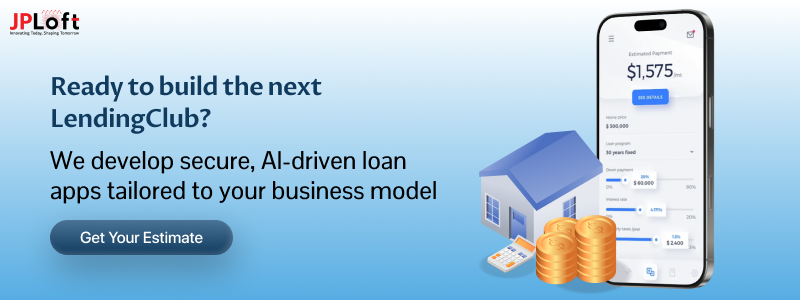
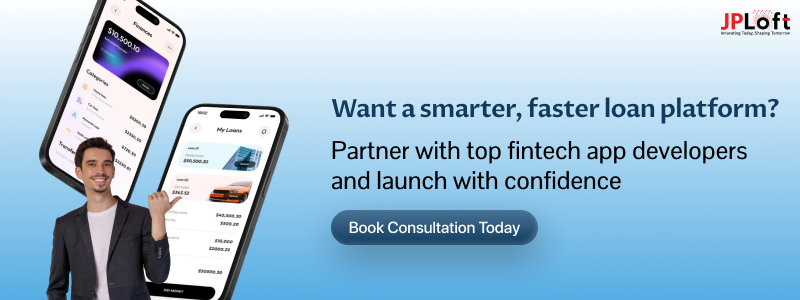

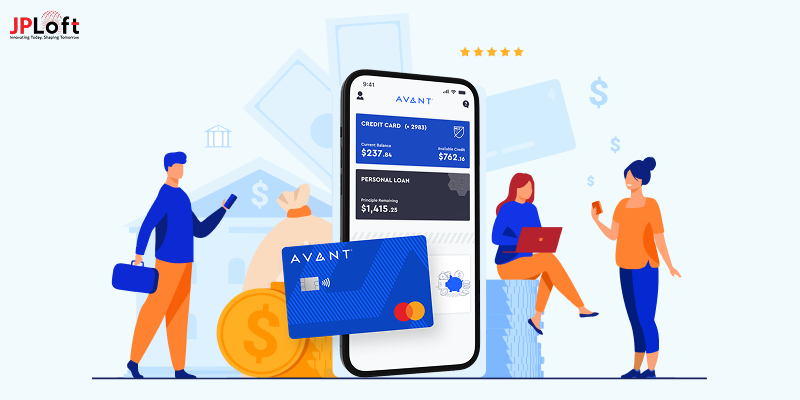
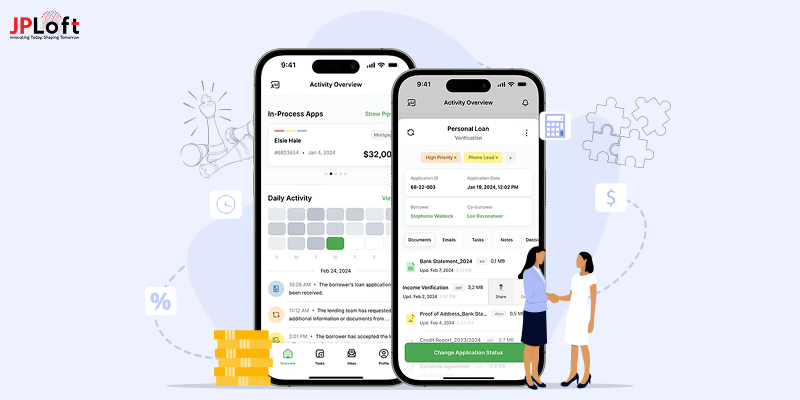
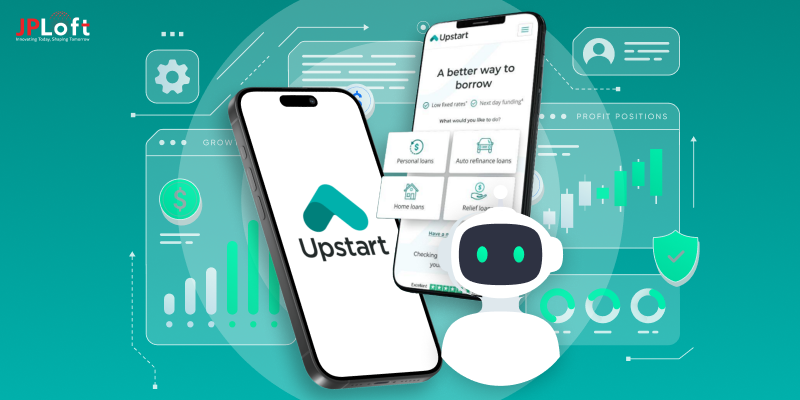


Share this blog